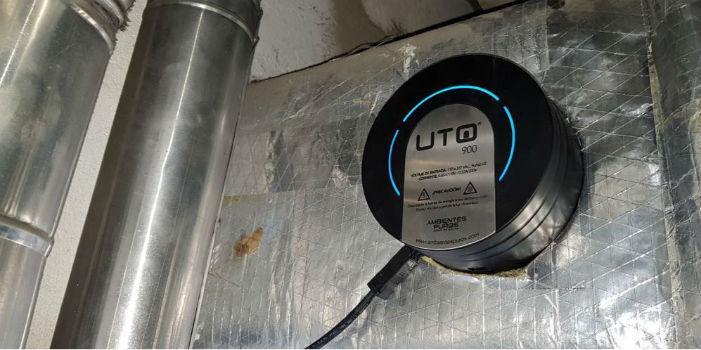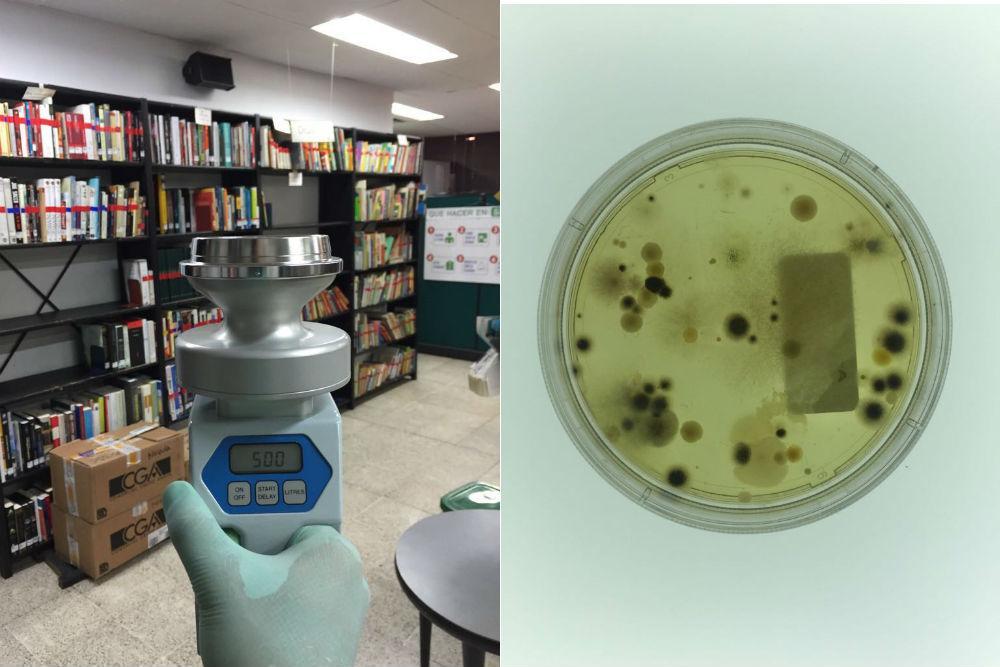 Let's know the characteristics and technical benefits of a new technology in air purification equipment.
Let's know the characteristics and technical benefits of a new technology in air purification equipment.
by Julián A. Restrepo R. and José Paulo Naranjo*
Introduction: Currently, office buildings and workplaces in cities around the world are increasingly sophisticated in terms of their originality, design and performance, buildings in which we work or live, in fact, in many cases, daily we spend much more time at work and with our colleagues, than in our homes and with our families. The fact is that, however, these buildings can provide some vulnerability for those who will occupy them and their inhabitants are not exempt from suffering the effects of the so-called Sick Building Syndrome (SEE) [1].
Also, and not least, we must talk about the so-called health care-associated infections (HAIs), also called nosocomial infections. According to the World Health Organization (WHO): Healthcare-associated infections represent a problem that affects approximately 15% of patients admitted to hospitals and 34% of patients in intensive care units in developing countries [2]. According to a 2007 report by the European Centre for Disease Prevention and Control (ECDC), IAAS is currently considered one of the most serious public health problems, with an estimated three million Europeans acquiring a healthcare-related infection each year [3].
It is therefore evident that there is a slow but growing concern about air quality, both indoors and outdoors and its effects on people. And it is that the issue of outdoor air quality can not be alien to that of indoor air, since a design recommendation for air conditioning systems is the use of outdoor air intake, but it must be recognized that, due to outdoor air pollution, some air conditioning systems are installed and in operation without outside air injection, which aggravates the problem of indoor air quality.
We know that in recent years, many of the world's major cities, including industrialized and developing countries, have repeatedly presented episodes of alerts for high outdoor air pollution, which has forced to take different measures to reduce the problem, including the restriction of vehicle traffic at certain times or throughout the world. day, promote the day without a car and the use of the bicycle, many of them related to urban mobility, rather than restrictions on the same industries or other possible sources. The issue is that many of these measures are unpopular and in many cases ineffective [4], which aggravates the problem and leaves us with a feeling of not having many alternatives.
In this sense, the technology of Oxidative Treatment Units (UTO) arises, air purification equipment based on the principle of photocatalysis, which emerges as a technological, simple, efficient, economical and robust alternative to reduce pollution levels in indoor environments. The objective of this article is to make a general review of the concepts of ESS, IAAS and other problems associated with poor indoor air quality and how purification technology based on Oxidative Treatment Units (UTO), constitutes an important technological alternative to consider and implement.
What is Sick Building Syndrome (SEE)?
The ESS can be defined as the set of various symptoms or conditions that gradually causes a property or building on the people who live or work continuously in it and who are not, in general, accompanied by any organic injury or physical sign, often diagnosed by exclusion [1], [5]. Although the specific causes that produce it are unknown, it is mainly attributed to the pollution of the air that circulates inside the building. In some cases, in principle, it is not a serious problem that goes beyond a temporary discomfort that reduces the respiratory capacity of people, but in extreme cases it can even aggravate in some related pathology [1].
Strictly speaking, there are difficulties in defining what is really meant by sick building and by Sick Building Syndrome (SEE). In practice, sick buildings are a part of the buildings that present problems. These buildings are generally equipped with air conditioning, although they can also be naturally ventilated. Its occupants present complaints regarding their health in a greater proportion than would be reasonable to expect (>20%) and the causes are difficult to identify since in many cases they have a multifactorial origin [5].
The WHO differentiates between two different types of sick building: the one that presents temporarily sick buildings, which includes new or recently remodeled buildings in which the symptoms diminish and disappear over time, approximately in half a year, and the one that presents the permanently sick buildings when the symptoms persist, often for years, despite measures being taken to fix the problems.
Historically, the issue of the effects that a worker can suffer on behalf of the work space in which he operates began to be talked about in the decade of the 80s in the US, on account of respiratory infections that multiplied in the winter season, when offices needed heating and the cold forced to keep the windows closed. Of course, the lack of air circulation ended in an ideal scenario for the transmission of viruses and germs, and this caused the proliferation of respiratory diseases and the consequent sick leave [6].
The SEE appears mainly in hermetic buildings that have centralized ventilation systems, window systems that do not open, with carpeted floors, carpets, etc. In this type of facility, for example an office block, air constantly recirculates through ducts carrying particles harmful to people's health. However, the ESS is not a problem unique to enclosed buildings. Cases have also been reported in buildings with good ventilation. In general terms, the World Health Organization (WHO) estimates that approximately 30% of the modern buildings that surround us can cause this syndrome in their occupants [1].
The most frequent discomfort caused by sick buildings has to do with the airways, but the catalog of symptoms is very varied. In fact, it is not uncommon to suffer several of them at once. The most common manifestations are [1]:
Nasal symptoms: irritation of the nose, heavy mucus, dry nose, congestion, smell disorder, or cough
Eye discomfort: irritation, tiredness, stinging and redness of the eye
Sore throats: irritation, dryness, hoarseness, swelling or redness of the throat
Skin disorders: irritation and stinging on the skin
Other manifestations are headaches, nausea, dizziness, mental fatigue or drowsiness, difficulty concentrating and allergies.
Normally, when leaving the building in question or after a few days these symptoms usually disappear or subside.
Healthcare-Associated Infections, Coming Soon [3]
Health Care Associated Infection (HAI) is that condition, localized or systemic, that results as a result of an infectious agent or its toxins and that was not present, nor in the incubation phase at the time of the patient's admission to a health center.
Since 2004, the 57th World Health Assembly approved the creation of the "Global Alliance for Patient Safety", with the purpose that all agencies, political groups and patients, converge to give effect to the principle "first and foremost, do no harm" and reduce negative health and social consequences, of unsafe health care for patients. IAAS are considered as adverse effects, and their study and monitoring has been incorporated into the hospital committees created in these entities for the monitoring of adverse effects linked to patient safety.
WHO estimates that, in the next 10 years, IAAS will be the most important public health problem, with growing economic and human repercussions, for the following reasons:
- There will be a greater number of people in overcrowded conditions within the health services.
- There will be a greater frequency of immunity deficiency (age, diseases with a predominance of chronic ones, treatments, cancer).
- New microorganisms or emerging diseases.
- Increased bacterial resistance to antibiotics.
The IAAS, in general, is a quality indicator that reflects and unifies all the activities that are carried out at the hospital level. Its appearance is influenced by a large number of factors related to the patient (both intrinsic risk factors such as obesity, diabetes mellitus, cancer and extrinsic as well as hand hygiene of staff and family members, adherence to the use of barrier methods cleaning, disinfection and sterilization of the material to be used) (see Figure 1, for sampling sites with microbial contamination).

Figure 1: Left: Use of Air Impactor, equipment used to make air intakes for microbiological measurements; Right: Microbiological cultures resulting from analysis of air samples (agar samples)
Other problems caused by poor indoor air quality
In addition to the aforementioned risks to people's health, whether in interior spaces of buildings through the ESS or in hospital entities through the IAAS, for entrepreneurs, an obvious one is the discomfort for people who, together with the lack of comfort and absenteeism of people due to their absence due to respiratory diseases, it translates into low productivity of companies and therefore economic losses [7]. For people themselves, it means a drop in their quality of life and in general, in their life expectancy, since many of these diseases become chronic and once they develop, they accompany many people for the rest of their lives.
Note: The second part of this article will talk about the importance of keeping indoor spaces clean and about the solution of Oxidative Treatment Units (UTO).
* Julián A. Restrepo R.- Research and Development - [email protected]
* José Paulo Naranjo - General Manager - [email protected]
Pure Environments - www.ambientespuros.com - Medellin, Colombia.
References
[1] https://www.webconsultas.com/belleza-y-bienestar/medioambiente/que-es-el-sindrome-del-edificio-enfermo
[2] https://www.paho.org/hq/index.php?option=com_content&view=article&id=10788%3A2015-infections-associated-to-health-care-and-hand-hygiene&catid=4669%3Aannouncements-hss&Itemid=39594&lang=es
[3] https://www.abchospital.com/infecciones-asociadas-a-la-atencion-de-la-salud/
[4] https://www.elespectador.com/noticias/bogota/estudio-alerta-que-aumento-contaminacion-en-bogota-durante-dia-sin-carro-y-sin-moto-articulo-738198
[5] http://www.insht.es/InshtWeb/Contenidos/Documentacion/FichasTecnicas/NTP/Ficheros/201a300/ntp_289.pdf
[6] http://www.eltiempo.com/vida/salud/sintomas-del-sindrome-del-edificio-enfermo-59885
[7] https://www.mundohvacr.com.mx/2015/03/el-derecho-a-la-calidad-de-aire-interior/














